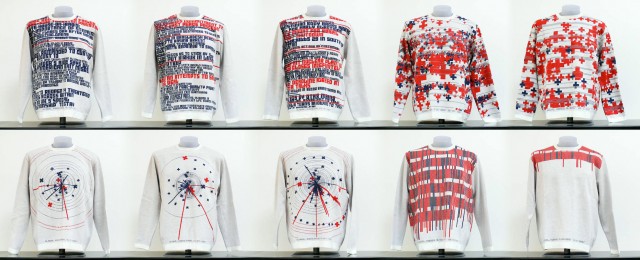Looking Outwards: Coding and Fabrics
Discuss one project that you admire (why?),
Dreamlines is a project created by Leonardo Solaas which creates unique, almost surrealist paintings based off of keyword users input into the form. The piece uses related images taken from the internet and merges and renders them into a new composite image, a painting. The project uses a combination of Processing and PHP with Flash as the user interface. The Processing reads images sent from the PHP and uses them to generate a drawing that is constantly changing.
What I really like about this piece is how dynamic it is. The paintings created from the searched words are constantly changing, utilizing an aspect of the internet and technology that I feel is sometimes overlooked: its constant changing and updating. In the other pieces I discuss below, the work is static despite the constant information and data being streamed into the projects and programs. However, I feel that Solaas’ piece really takes into consideration the dynamic nature of the internet and technology and this is reflected in a piece that is constantly changing and upgrading. This piece really feels interactive with an interface that like the project, is constantly moving. Another thing I really admire about this piece is its accessibility. A lot of times art seems so constrained and detached from the public but this piece, because it is online and uses the internet especially, makes the art available to everyone, critics and spectators alike and I really like that. My only real gripe is that you have to click submit, instead of enter, to have the image be rendered.
http://www.solaas.com.ar/dreamlines/p5/
One project that surprised you (why?),
The project Fragmented Memory is a collection of large woven tapestries that works to render invisible digital information and photography through woven tapestries. However, what I found most interesting about the work is that it doesn’t only work to render the digital information on the tapestries, but to capture and store that data. Essentially the tapestries are like a combination of all the digital information in a computer’s memory expect on a physical level, represented in woven string instead of pixels and memory.
This project is especially compelling to me because of the concept of physically representing digital information. Through this project they were able to make data, something so seeming ethereal and elusive tangible. In order to visualize memory they extracted Phillip Stearns’ physical memory from his computer. They converted the data into images using custom software written in Processing which grouped the six bit info into RGB colors.
In the comment section of Phillip’s page, I noticed an interesting comment that left a link to a BBC program. In the program it linked computers to looms, essentially noting the close relation of the information processing to the looming process. I think that was a really interesting connection to computers and fabrics. Learning of this connection really added another layer of depth to the piece.
http://phillipstearns.wordpress.com/fragmented-memory/
And one project that missed an opportunity (why?).
News Knitter is a projected created by Ebru Kurbak and Mahir Yavuz which converts news feed of a certain day or period into visualized text and data that is then printed on a sweater. Like the looming project I mentioned before, this is another project which uses computer data and converts it into garments. The project uses processing to convert the constant news feeds into visual representations which is then sent to knitting machine which creates the sweaters. I really like the concept of the project and the overall execution. If you look below, you’ll see that the sweaters the program prints are visually appealing, especially with its striking blues, reds and blacks which are very akin to the colors we see in political spheres.
http://casualdata.com/newsknitter/images/nk_sweaters_full.jpg
Despite this, I find that the process in which the information is selected and filtered isn’t explained very well or doesn’t appear to reflect very much in the overall pieces. The sweaters have streams of words or graphs, but the information it is trying to convey is lost because of the fact that there doesn’t seem to be a filter in which the news is selected. I feel like this is one of those cases where because they are selecting from so much information and not really seeming to do much to filter or organize it, it doesn’t mean very much. I think this project could be more effected if the sweaters and news were categorized in some way. If they could filter out all the news regarding one subject, Israel and Palestine news for instance, and create a series of sweaters based off that news for the day, and so on, then the information being conveyed from the sweaters would have more impact. However, right now they are simply just a series of sweaters that relay old news.
http://casualdata.com/newsknitter/
